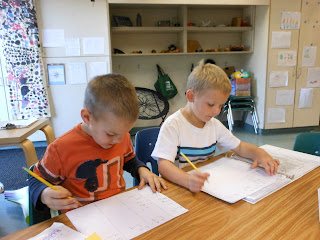This past week has been full of fun language games that have really got the friends laughing! As many of you know, "Change the Vowel" is a favorite game in our class, especially when we are changing the vowels in our names to make silly new names. The students have continued their exploration with different vowel sounds by listing all the different words they can make using a consonant-vowel-consonant pattern. Students are noticing the relationship between letter and sound, which letters are constant and which get changed in the pattern, as well as practicing reading each word to find which words are actual words and which are made up words that give us a good laugh!
Another fun language game some friends have been practicing is "Change the Consonant." They are using the same consonant-vowel-consonant pattern, but instead of changing the vowel in the middle, they are changing the consonant in the front with different puzzle pieces! For example, using the -at ending, friends can use different consonants in the front and find new words, like, cat, bat, rat, sat, and many more words that rhyme!
During one of our discussions, some friends were really curious about the time and how to read the clock in our classroom. Many students are able to read the clock to give a hint about what time of day it is, but not exactly tell the time. Some might know that when the big hand touches the nine after Songs and Poems, it is recess; or when the big hand touches the nine after our Revisiting Meeting, it is time for lunch; even when the big hand touches the six after Calendar and Journal, it is the end of our day. But the concept of time is still a mystery.
We started dissecting the different parts of the clock in our room and becoming familiar with what each number represented. The terms hour, minutes, and seconds came up which prompted us to note what the different symbols on the clock meant. Each large number indicated what hour of day it was, and each small line represented one minute. We checked to see how many minutes were in an hour and some friends were quick to notice that you can count by fives to tell how many minutes have passed. This is still a big concept that is going to require more analyzing and practice, but it is neat to see that the students have been thinking about it!
Has your child talked to you about Mrs. Piggle Wiggle? I spend a few days a week reading from this book to the class and we have had such a ball learning about the unconventional ways that Mrs. Piggle Wiggle makes doing chores around the house fun!
We have also been continuing our study on the elements to story writing and documenting what we know about the book, starting with the title, the characters and the setting. This helps wrap our minds around sharing just a little bit of information, mentioning some key information but without giving too much away.
The next step I have briefly introduced the students to is showing which are the main points of the plot summary, but again, without telling the secret of the book. We worked together as a group to decide which events were most important from the first chapter of Mrs. Piggle Wiggle, which illustrations would best convey the message, and what information would be enticing enough to make the reader want to know more about the book.
Come on in to check out our Reading Log on the information table to see which books your child has been enjoying during Relax and Reading time, and their first attempts to document key information about them.
Love, Gaby



























































.JPG)
.JPG)
.JPG)